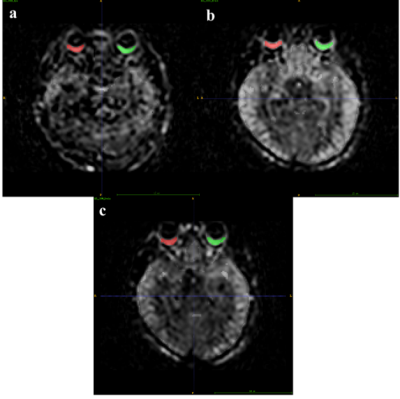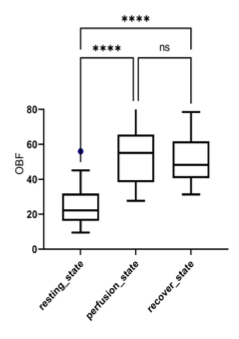2949
Effect of Dobutamine Stress on Ocular Blood Flow Measurements Using 3D Pseudocontinuous Arterial Spin Labeling1Beijing Advanced Innovation Center for Biomedical Engineering, School of Biological Science and Medical Engineering, Beihang University, Beijing, China, 2Beijing Friendship Hospital, Beijing, China, 3Chinese Academy of Sciences, Beijing, China
Synopsis
Dobutamine stress testing is a very widely used tool in cardiological investigation. However, little is known about the effect of dobutamine on adult ocular blood flow with clinical dosage. In this study, we infused dobutamine in human subjects and examined the effects of dobutamine on ocular blood flow using 3D pseudocontinuous arterial spin labeling(3D-pcASL). Dobutamine infusion significantly increased the ocular blood flow. And the heart rate and diastolic blood pressure were the main factors affecting the ocular blood flow.
Introduction
Dobutamine stress testing is a very widely used tool in cardiological investigation 1. However, little is known about the effect of dobutamine on adult ocular blood flow(OBF) with clinical dosage. In this study, we infused dobutamine in human subjects and examined the effects of dobutamine on OBF using 3D-pcASL.Methods
A total of 23 participants (46 eyes) were recruited in our study. The experimental protocol was approved by the Research Ethics Committee of Beijing friendship hospital, Affiliated with Capital Medical University (2020-P2-155). Before the experiment, all subjects signed informed consent forms, which were archived. All the participants underwent routine systemic and ophthalmological examinations. The physical characteristics of participants such as age, BMI and myopic diopter were collected. During the resting, prefusion and recover periods, the physiological parameters such as heart rate(HR) and blood pressure(BP) of the participant were monitored synchronously and continuously by a portable Multi-parameter Vital Signs Monitor (Mindray, BeneVision, Shenzhen, China). All participants were examined using a 3.0-T MRI scanner (Ingenia 3.0T; Philips Healthcare, Best, Netherlands) with an eight-channel phased array coil. The ASL data were obtained using a pseudocontinuous ASL sequence with a multislice fast spin-echo acquisition and background suppression. Fig.1 showed the course of the examination. Firstly, ASL data of eye perfusion were collected in resting state. After a 10-minute rest, dobutamine was injected, and the data of eye perfusion ASL in the perfusion state were collected. Finally, dobutamine injection was stopped, and ASL data were collected after BP and HR returned to resting state.The OBF map was automatically derived from the ASL images using a dedicated workstation. A region of interest (ROI) was placed independently by a radiologist and an ophthalmologist in the fundus at the level of the optic nerve in the OBF map, as shown in Fig. 2.One-way ANOVA was used to compare the three status groups. The paired T test was used to compare the left and right eyes in the group. The difference was statistically significant (P < 0.05). The age, myopic degree, BMI, HR in resting/ perfusion state, diastolic blood pressure(DBP) in resting/perfusion state, systolic blood pressure(SBP) in resting/perfusion state on OBF was evaluated using multiple regression analysis. We introduced the above parameters as the independent variable multiple factors regression analysis, the difference between the perfusion state and the resting state was taken as the dependent variable.Results
For one-way ANOVA analysis, there were significant differences between resting and perfusion state, resting and recover state (P <0.05), and no significant difference was found between perfusion and recover state (P>0.05)(Fig. 3). The result of paired T test showed that there was no significant difference between them.The results of regression analysis showed that HR and DBP in resting state were the main factors affecting blood flow (P<0.05), as shown in Fig. 4.Discussion
In the study, the effect of dobutamine on the OBF of adults was investigate. Our results suggested that dobutamine could increase the OBF and the HR and DBP were the main factors affecting the OBF. The heart of the load can be triggered by dobutamine through beta adrenal receptors1, this led to the increase in arterial blood pressure 2,3. In this study, OBF was significantly increased when dobutamine was injected, and there was a significant difference in ocular blood flow between dobutamine injection and none-dobutamine injection. The increased cardiac load caused by dobutamine increases systemic blood pressure moderately, which may increase ocular perfusion pressure and affect changes in OBF.In addition, multiple regression analysis was used in our study to analyze the relationship between the increase of OBF after dobutamine injection and physical characteristics. Ravalico et al.found that the ocular pulse amplitude and OBF of normal people decreased with age 4. In this study, since all the subjects belonged to the youth group, it was difficult to directly reflect the correlation between age and changes in OBF after dobutamine injection.It has been shown that OBF decreases in normal subjects as axial eye length increases 5. In this study, the degree of nearsightedness of subjects did not significantly contribute to the change of eye blood flow after dobutamine injection, which was inconsistent with the findings of previous studies on the occurrence of low perfusion in highly myopic eyes 6, possibly because the myopia degree of all participants was not high enough to reflect abnormal perfusion.Conclusion
Our preliminary results demonstrated that 3D-pcASL may be a useful tool to characterize alterations in ocular perfusion. Dobutamine could cause an increase in OBF, HR and DBP in resting state were the main factors affecting blood flow.Acknowledgements
This work was supported by Beijing Scholar 2015, Space Medical Experiment Project of China Manned Space Program (No. HYZHXM01012) and National Natural Science Foundation of China (No. 61931013).References
1. Ogoh S, Moralez G, Washio T, et al. Effect of increases in cardiac contractility on cerebral blood flow in humans. Am J Physiol - Hear Circ Physiol. 2017;313(6):H1155-H1161. doi:10.1152/ajpheart.00287.2017
2. Ruffolo Jr R R. The pharmacology of dobutamine[J]. The American journal of the medical sciences, 1987, 294(4): 244-248.
3. Dubin A, Lattanzio B, Gatti L. The spectrum of cardiovascular effects of dobutamine-from healthy subjects to septic shock patients[J]. Revista Brasileira de terapia intensiva, 2017, 29: 490-498.
4. Ravalico G, Toffoli G, Pastori G, et al. Age-related ocular blood flow changes[J]. Investigative ophthalmology & visual science, 1996, 37(13): 2645-2650
5. Mori F, Konno S, Hikichi T, et al. Factors affecting pulsatile ocular blood flow in normal subjects[J]. British journal of ophthalmology, 2001, 85(5): 529-530
6. Yang Y S, Koh J W. Choroidal blood flow change in eyes with high myopia[J]. Korean Journal of Ophthalmology, 2015, 29(5): 309-314.



